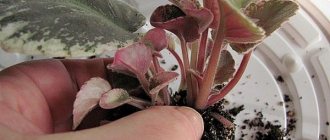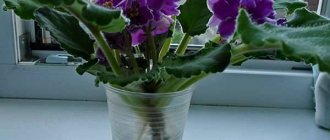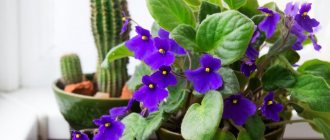Of all the indoor plants, the violet is perhaps the easiest to propagate. Our master class will help a beginning Saintpaulist understand the nuances of this process.
Leaf cuttings are a simple and quick way to get several Saintpaulia babies at once. The leaves take root quickly. And, despite the fact that the best time for cuttings at home is considered to be spring, summer and early autumn, violets can be propagated all year round. The main thing is to provide the plant with good lighting.
Traditionally, violet leaves are rooted in soil and water. You will learn how to do this correctly in our master class.
Propagation of violets by leaf cuttings is not suitable for Saintpaulia chimeras. For them, other methods are used, for example, rooting the peduncle or using stepsons formed in the axils of the leaves.
Violet propagation methods: pros and cons
Depending on the experience in propagating Saintpaulia, everyone can choose the method that suits them. It is useful to know them all, because sometimes there is no choice at all, depending on the condition of the mother plant.
Rooted Saintpaulia leaf with children
Leaves
Any strong leaf without signs of disease or spoilage can become an excellent material for vegetative propagation of a Saintpaulia rosette. The optimal time is March, when there is no heat and the days are longer. But as an emergency rescue measure, the method can be used almost year-round.
Pros:
- material is always at hand;
- large output of children: from one sheet to several dozen rosettes;
- practically guaranteed results if you follow simple rules;
- can be carried out all year round.
Minuses:
- Rooting in March gives the best results;
- violation of the maintenance regime will lead to the death of both the leaf and the children;
- The minimum time to receive children is two months.
Having gained experience on how to plant violets in a pot with a leaf, in the future you can repeat it as many times as you like, noticing additional nuances.
Cuttings, stem parts
This type of propagation is practically no different from leaf propagation and is used when there is no whole and strong leaf on the plant. Therefore, they take a leaf cutting with a piece of the main vein or cut out the central part of the stem. The longer the cutting, the better. A part of the stem 1-1.5 cm long is taken from the center, removing the crown (if it is in poor condition), as well as the entire lower part with roots.
Important! For cuttings, they use a very sharp knife, and all the sections are slightly withered, and then treated with alcohol.
Part of a violet stem with crown and young roots
Planting material is buried 1-1.5 cm into the soil and covered with a transparent cap. In such a greenhouse, viable parts of the violet will be able to produce roots over the next 2-3 weeks. If you take a container with transparent walls for planting, then soon the roots will be clearly visible. Part of the stem, like the cuttings, should produce children, which in 2-3 months can be carefully planted in separate pots.
Advantage: Large parts have more vitality for growing young roots. Disadvantage: if there is some kind of fungal disease, there is practically no chance of rooting.
Peduncle
Some varieties of violets, for example, chimeras, can only be bred in larger quantities this way. Seeds and leaves do not carry a full set of genes that allow them to preserve the unique shade of flowers and their shape, as well as leaves. To obtain clones, take flower stalks and root them in the same way as leaves.
The rooted part of the peduncle
Advantage of the method: 100% preservation of all the features of a rare variety.
Disadvantage: extreme painstaking technique and low survival rate of peduncles (on average 1 out of 4-5 or less).
Seeds
Violet seeds are very small, which makes them difficult to handle. They are practically never found on sale. The main reason: short germination period (up to four months). Therefore, the method is used exclusively by those who are purposefully involved in breeding new varieties. Plus: you can get new shades of flowers by crossing violets with different traits.
Preparation of planting material
The success of violet propagation by cuttings is largely determined by the quality of planting material. Choose healthy, strong leaves without defects, located no lower than the second tier. It is necessary to cut the leaf for rooting with a clean, sharp knife or blade treated with an antiseptic.
Withered or drooping leaves should be placed in warm water with the addition of two or three crystals of potassium permanganate. This will restore the freshness of the planting material and disinfect it. Then the cuttings are cut at a distance of about 4 cm from the leaf plate and rooted in any convenient way. The larger the angle and area of the cut, the higher the likelihood of forming a good root system.
Rooting a violet leaf in water
How to replant violets at home
You can root in soil (2-3 weeks) or in water (about four weeks). Within 1-3 months after rooting, babies appear. To maintain optimal humidity, the cup with the leaf is kept under a hood or in a greenhouse.
Rooting violets in water
How to root a violet from a leaf: preparation for germination
If the leaf has been lying for a long time (more than 5 hours), then it should be allowed to soak in water with a drop of potassium permanganate (2-3 hours). It is best to use leaves of 2-3 tiers of the rosette for propagation. The cutting is left up to 2 cm long. If part of a leaf is used, then the cut is given 15 minutes. dry, immediately wiping with alcohol.
Optimal conditions
It is best to use a transparent plastic greenhouse with a lid. Once a day, open the lid for ventilation. If there are traces of spoilage on the sheet, then do not cover it with a lid. Additional lighting is not needed if you start working in the spring or summer.
Do you need fertilizers?
Violet grown from leaves must be fed to form rosettes and create lush buds. Fertilization of young plants is carried out once every 7 days. During the flowering period, fertilizing is added to the pot once every 14 days. During the dormant period (late autumn, winter), fertilization with superphosphate is carried out monthly. Nutrients are introduced during irrigation dissolved in water.
When planting an adult plant, experts do not recommend fertilizing for 1 week, because the new soil mixture has the necessary nutrients.
During the period of bud formation, violets require fertilizing with complex fertilizers (“Uniflor-bud”, etc.). After flowering is completed, the plant is fertilized with Uniflor-rost or universal compounds Etisso, AVA, Schultz.
When placing plants on racks, it is necessary to provide a larger volume of fertilizing and organize lighting. If the temperature and air humidity are maintained, the bushes grow quickly and require replanting.
How to grow violet from a leaf at home in agroperlite
How to grow mint at home on a windowsill
This relatively new method has several important advantages over rooting in water. In agroperlite, the roots grow the same as in the soil, which simplifies the adaptation process when transplanting into the ground. Agroperlite is sterile, breathable, and retains moisture well. It can be used solo or mixed with vermiculite and peat. On average, a cutting sprouts roots after three weeks, after which it is 100% ready to be planted in the soil.
Germination of violets in agroperlite
Reasons for the absence of children
The reason why a violet leaf does not produce children may be due to the cuttings being planted too deeply. The shoots formed at its base simply cannot hatch through the thickness of the soil.
The problem of why cuttings do not produce children for a long time may also be hidden in the composition of the soil. The soil for vegetative propagation should be loose and breathable, then there is a greater chance that the leaf will sprout.
Sometimes flower growers decide to radically combat the problem of lack of offspring. If the children do not grow, what do they do: re-cut and root the mother leaf. The chances of success with this method increase significantly.
Propagation of violets by leaf at home step by step
You can immerse a freshly cut leaf into the soil without any hindrance; no preparation is required; it is only important to create suitable conditions for root growth. Using a root will speed up the process, but even without it the chances of rooting are high.
The soil
How to grow fuchsia from seeds at home
In a cup (5 cm in diameter), drainage (sand, fine expanded clay) must be placed at the bottom, and holes are also made for water drainage, through which it is best to water. You can buy the correct soil for rooting in the store or prepare it yourself by mixing vermiculite and perlite, peat, finely ground charcoal with fertile soil. The proportion of leavening agents is up to 30-50%. Optimal acidity pH=5.5-6.5.
Note! Experienced gardeners recommend introducing a small amount of finely crushed eggshells.
Temperature, humidity, lighting
Violets can grow well in temperatures ranging from 14°C to 29°C. A temperature of 20-22 °C is suitable for adult plants, and 24-26 °C for rooted cuttings. A jump of more than 3 °C per day already slows down development, and more than 6 °C will cause it to freeze for a long time. Violets love humid air (above 60%), but do not react well to drops of water on leaves and flowers. It is optimal to place the pot in an additional second tray filled with water, and keep the first one dry after watering.
Saintpaulia loves bright light, but diffused on eastern and western windows or in the shade of taller plants.
Soil quality for planting the leaf
To obtain soil with the required looseness and structure, components are introduced into it that increase air capacity and the ability to retain moisture: vermiculite, perlite, charcoal, sand, sphagnum moss. All of them do not disturb the acid balance and do not change the bacterial composition for the worse.
Important! It is better to heat the finished soil in the oven to kill mold, disease and insects.
Aftercare
Necessary conditions for the favorable development of Saintpaulia grown from a leaf:
- suitable soil;
- sufficient watering;
- lighting for at least 12 hours;
- air humidity about 65%;
- comfortable temperature, from 22 to 26 degrees.
It is not difficult to create such conditions, and soon the violet will delight its owners with its flowering.
A violet grown according to all the rules must be at least 20 cm and no more than 40 cm in diameter. Large stepsons need to be planted, and the flower must be grown in one trunk, which should not bend. Leaf deformation is not allowed. The bottom row runs parallel to the pot, and the top row runs at an angle of about 40 degrees.
How to propagate a violet with a peduncle
As soon as the peduncle grows to its maximum height and its buds bloom, the flowers are carefully cut off. The peduncle itself is cut off as close as possible to the point of its growth from the rosette. There should be a fork with 2-3 green leaves left. The lower end is immersed in soil for violets and must be covered with a transparent cap on top, leaving in a warm place (20-22 ° C). Water the pot with a pipette very rarely and carefully, since waterlogging is detrimental to the peduncle and its roots. Rooting takes 2-3 months.
Choosing a cutting
How to breed violets? Most often, the leaves of the plant are used for propagation. For successful rooting of cuttings, it is necessary to choose the right planting material. Flower growers recommend taking a leaf 2-3 rows from the bottom. The lower foliage is not suitable for rooting because it is already old. It takes a very long time for children to grow out of it. But young leaves must be selected carefully so as not to damage the center of the rosette.
The selected cuttings should be elastic and without damage. Unfortunately, chimera varieties with multi-colored colors cannot be bred without losing the characteristic color of the leaves. Such plants are often propagated using stepsons or flower stalks.
If for some reason the cutting has lost its elasticity, it must be soaked in a weak solution of potassium permanganate for several hours. After the procedure, the leaf should dry completely. And only after that it can be planted.
Typical germination mistakes
Negative results often occur during the first attempts to breed Saintpaulia. Reasons for failure:
- Leaf rotting. Most often it happens due to waterlogging, especially in winter. To speed up rooting, the cut is dipped in root material before being immersed in the soil.
- Water in rooting cups is disinfected with activated carbon.
- The rooted leaf became limp. You should place it in a greenhouse and reduce watering for a while.
- The leaf turned black. This happens due to excess moisture and sunburn. The pot should be placed in a greenhouse away from direct sun and dried.
Note! The general rule is: it’s better to dry it out a little than to fill it with soil. When rooting in water, you should change it to clean water every day and wash the glass.
Transplanting violets after germination
As soon as the rosettes of the children have formed, they are carefully separated and transplanted into new containers. The optimal time is autumn (September-October). Winter is the most inappropriate period. The next time the pot will be changed will be in the spring (February-March).
How to determine whether a plant is ready for transplanting
The signal for replanting is the filling of the pot with roots, as well as a white coating on the surface of the soil - mineral sediment. If the roots prop up the walls of the pot and peek out from the lower drainage holes, this is an already advanced case and replanting is required urgently. The goal is to change the soil to a new one rich in nutrients. New roots grow from the part of the stem that is above the soil. Therefore, the plant is freed from old lower leaves (if necessary), and the stem is slightly buried.
Children are separated from each other
Note! You can leave the pot the same. When increasing the capacity, flowering will not occur until the violet has mastered the new volume.
How to choose and prepare soil for planting
The soil is suitable with acidity pH=5.5-6.5. When choosing a ready-made substrate in a store, preference is given not to black, but to brown soil, rich in coarse-fibered high-moor peat. Various leavening agents are mixed into it by a third of the volume: sand, charcoal, vermiculite, coconut fiber, perlite, sphagnum moss.
Humidity, temperature, lighting
After waiting until the soil dries, remove the violet from the old pot and carefully shake off the old soil. Long, old and rotten roots are removed. Pinch off the bottom row of leaves if they look unattractive, given that this will delay flowering for at least a month.
The first two days after transplantation, watering is not carried out to give time to the root injuries. The pot is placed in a warm place (23-25 °C). If the air is very dry (humidity 50% or less), then use a greenhouse.
Important! Lighting is required for 12 hours, so if the daylight hours are too short, it is advisable to organize additional lighting.
Propagation of violets by seeds
If a collector is lucky enough to come across Saintpaulia seeds for sale, then growing varietal plants from them is not too difficult at home.
What seeds suitable for growing look like
It is visually impossible to distinguish germinating seeds from non-germinating ones; they are too small. Their color ranges from black to dark brown. The only guide to germination is the production date specified by the supplier.
Saintpaulia seeds
How to prepare seeds for planting in soil
To distribute the seeds over the soil surface, they are pelleted. Take several tablets of activated carbon and crush them into dust. Then the coal and seeds are mixed. Drop a few drops of water into the mixture and mix gently. You should get small lumps - dragees with seeds inside.
Optimal conditions for seed germination
The decisive factor is temperature. At 20 °C, seedlings will appear in three weeks, and at 25 °C - in two weeks. Sowing is carried out in a container on the surface of the soil, practically without deepening it (you can lightly powder it with fine, clean sand). Moisten with a spray bottle and then cover with a transparent lid or glass. Choose a place that is bright, but without direct sun, slightly shaded.
Saintpaulia shoots
Rules for caring for young shoots
In order for the seedlings to grow, but not stretch, you need to lower the temperature to 17-18 °C. Watering is carried out so that the soil is slightly moist, but not soggy. Overwatering can destroy all seedlings. Dive when the first true leaf is formed into a larger container. After another 10 days, you can plant them in the first smallest pots (5-7 cm in diameter).
Picking Saintpaulia seedlings
Growing Saintpaulias at home is a very exciting process, fraught with a lot of interesting nuances. It may seem difficult, but learning how to propagate violets in different ways comes quickly, and the results are definitely worth the effort.
What to do if children grow slowly
After the Saintpaulia cuttings have sprouted, some rosettes immediately begin to grow, while others sit in the ground almost unchanged. There may be several reasons why children grow slowly. The main factors influencing the development of rosettes are considered to be an unsuitable microclimate, untimely watering, too much or insufficient irrigation, fertilizing and the condition of the root system of young Saintpaulias.
If optimal temperature conditions are created for the shoots, additional artificial lighting is used in winter, the most suitable watering method is selected, and the young rosettes still do not grow, fertilizer should be applied to the cuttings. For young Saintpaulia rosettes, choose fertilizing with a high nitrogen content. The concentration of the solution should be 8 times lower than for adult plants.
Important! The most effective way to speed up the growth of any plant is to replant it. In this case, it is recommended to replace the substrate. For this, a new soil is prepared, consisting of peat, perlite, moss and wood ash. It should be light, nutritious and breathable.
If replanting also does not produce results, transferring it to a larger pot will help. Sometimes the cutting sends out too many shoots and they become crowded. In addition, the grown mother leaf can block light from young shoots. It should be cut off a little on top, and then transplanted together with the children into a container with a large diameter. You need to make sure that the Saintpaulias do not end up in the depths of the pot. With high sides it will be difficult for violets to develop.











